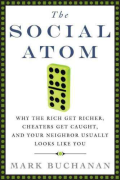My Account
Subscriptions
Summary Categories
Summary Collections
- Career & Life Satisfaction Collection
- Disruptive Innovation Collection
- Exceptional Leadership Collection
- Great Employees Only Collection
- Hidden Gems Collection
- Marketing Collection
- Must-Read Books for 2012 v1
- Must-Read Books for 2012 v2
- Must-Read Books for 2013
- Self-Help Collection
- Small Business Collection
- Strategic Assessment Collection
- Strategic Genius Collection
- Take Charge Collection
- Team Management Collection
- Ultimate Sales Collection
- Web Marketing Collection
Summary List
The Social Atom:Why the Rich Get Richer, Cheaters Get Caught, and Your Neighbor Usually Looks Like You
Mark Buchanan
Summarized March 2008
Type: [SUMMARY]
SKU: 3082
ISBN: 1596910135
Price: $12.50
Available Formats:




Purchase Summary
Summary Description
Why does one company succeed and another firm fail? What causes the stock market to rise and fall? Why do neighborhoods gentrify all of a sudden? Why are some bars crowded one week and empty the next?
You can find the answers to these and many other questions by looking at patterns the way that physicists look at atoms. For years, the idiosyncrasies of human behavior have confounded economists and social theorists.
Now, as our summary of The Social Atom by Mark Buchanan explains, we’re witnessing a “quantum revolution” in the social sciences. Buchanan is a theoretical physicist and an associate editor at Complexus, a journal on biocomplexity. He has been an editor at Nature and New Scientist, and is the author of two prize-nominated books, Ubiquity: The Science of History and Nexus: Small Worlds and the Groundbreaking Science of Networks.
In this summary, you’ll learn how the laws of physics are beginning to provide a new picture of the human or “social” atom. Just as atomic-level chaos gives way to the clockwork precision of thermodynamics, so can free individuals come together in predictable patterns. The insights you’ll gain will allow you to dissect fads, anticipate which companies will win, and understand whether your next product will attract customers -- or collect dust.
 Member Log In
Member Log In